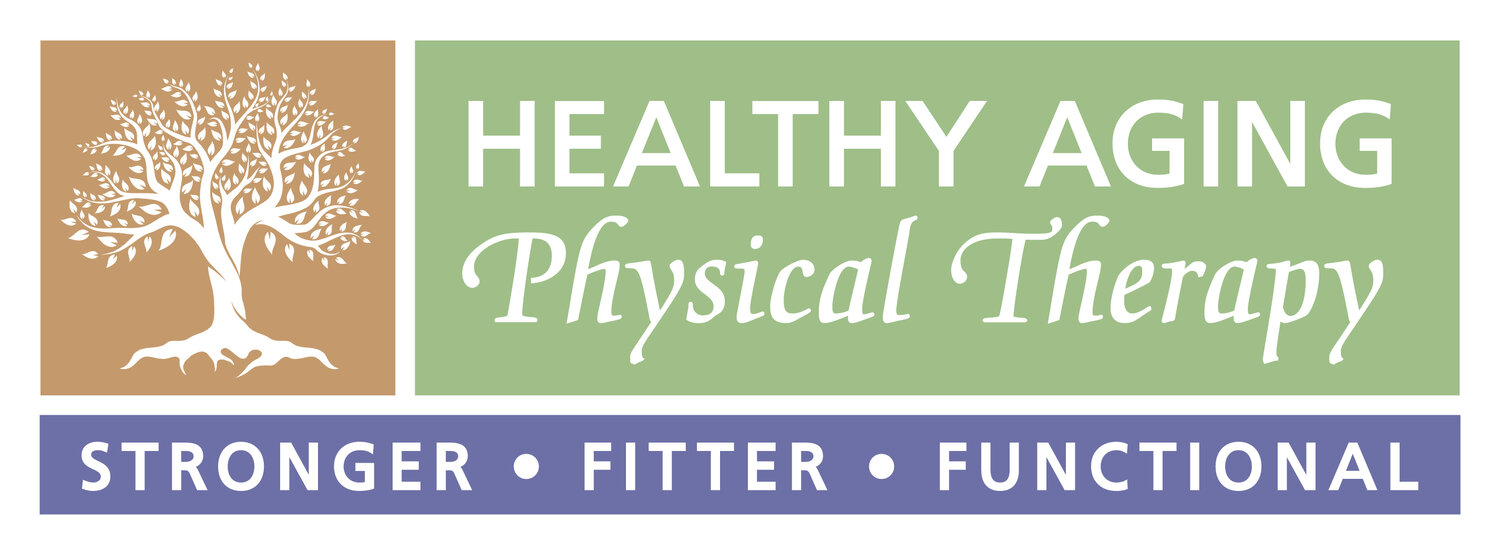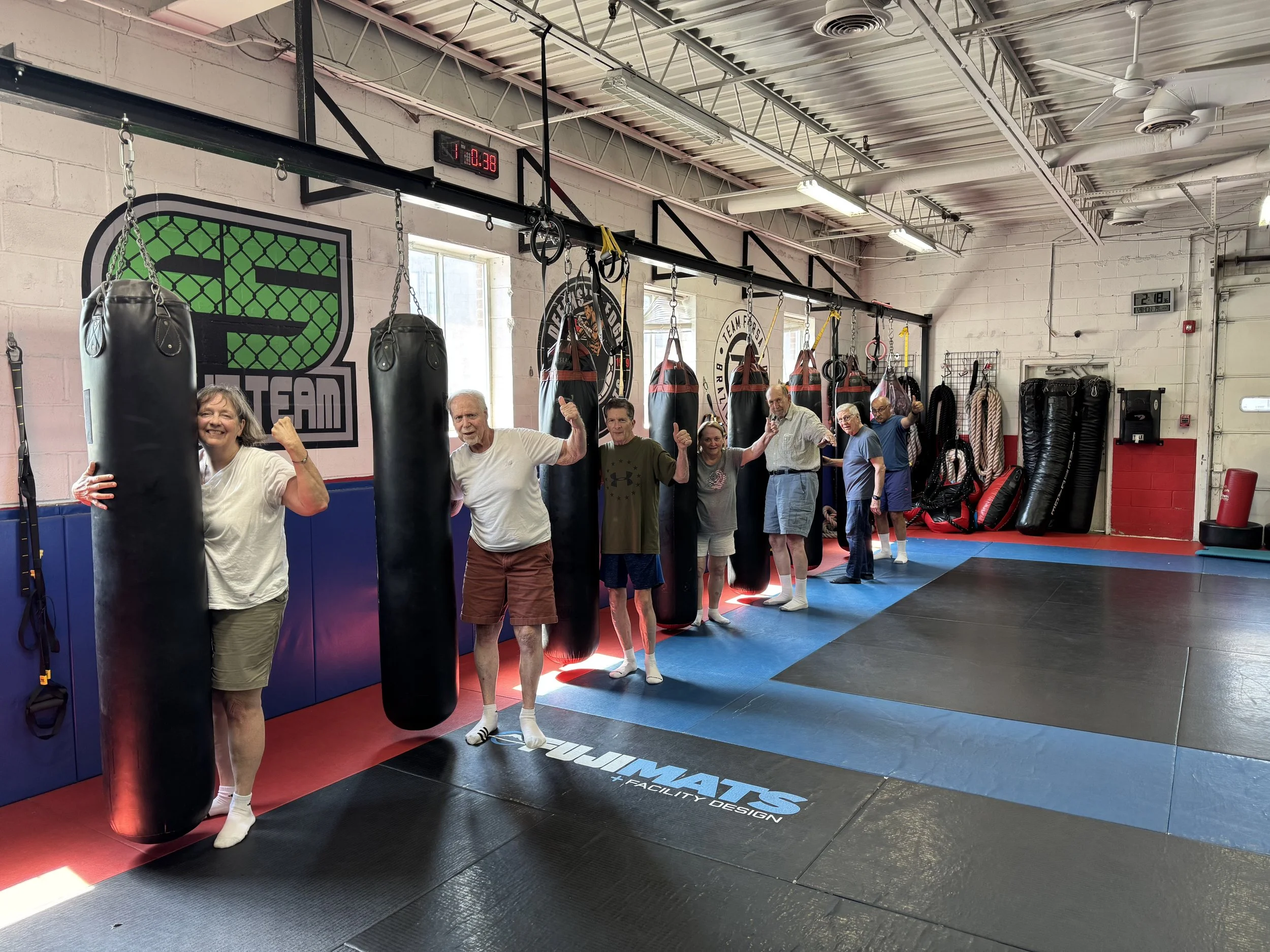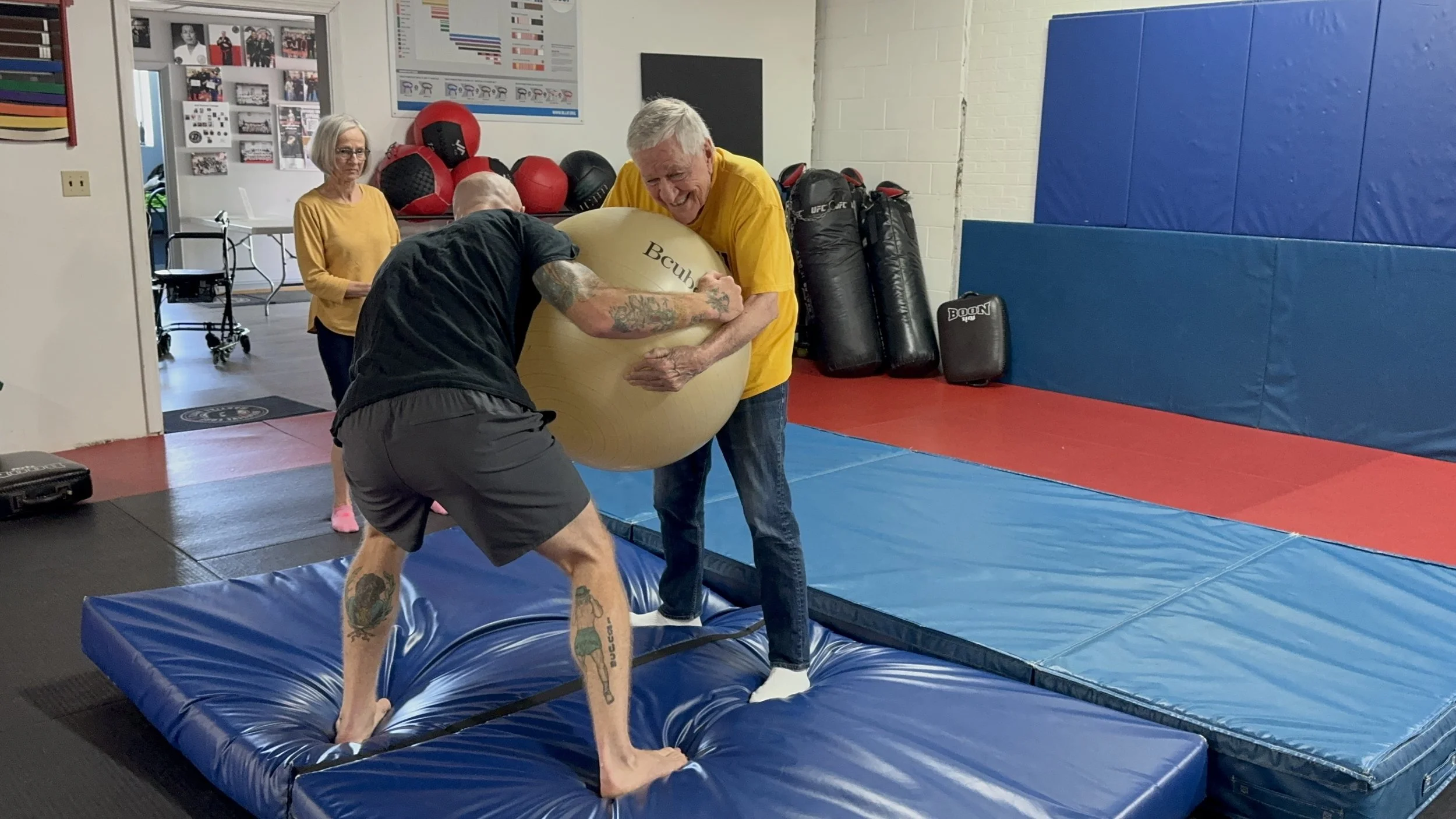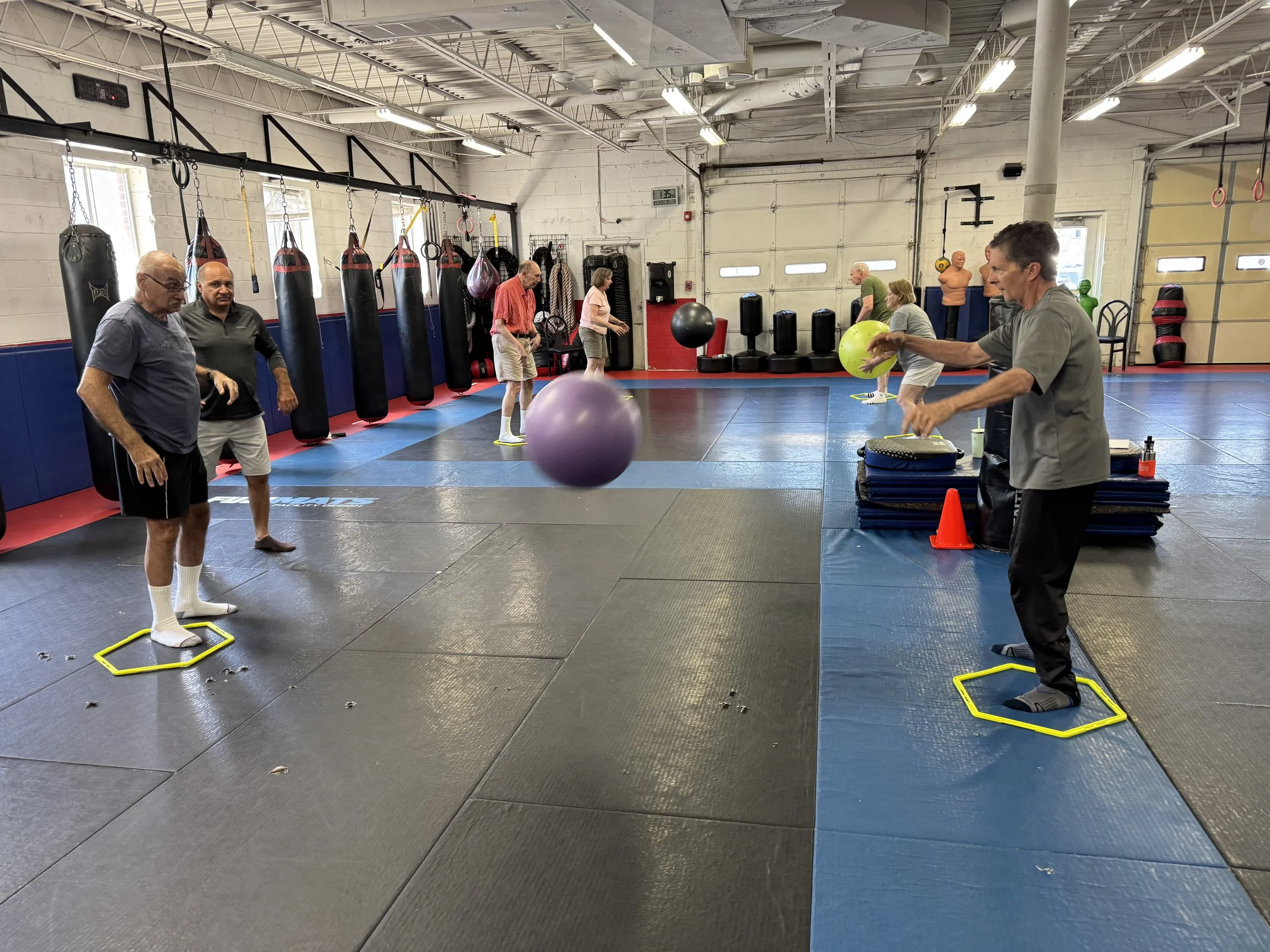Healthy Aging Physical Therapy Monthly Blog
Don’t Fall this Fall! Your Guide to Preventing Falls and Staying Strong
Fall Prevention Tips for Older Adults | Healthy Aging Physical Therapy
Discover evidence-based fall prevention strategies using the CDC STEADI framework, including strength and balance training, vestibular therapy, home safety modifications, and fall preparedness education. Learn how Healthy Aging PT helps older adults reduce fall risk and stay independent through 1:1 therapy, personal training, and group classes like Strong and STEADI and Fit & Fearless.
As the leaves begin to fall, let’s talk about a more serious kind of fall - one that affects 1 in 4 older adults each year. Of those, 1 in 5 results in serious injury, including broken bones and head trauma. Even more concerning: once someone experiences a fall, their risk of falling again doubles.
But here’s the good news - falls are not an inevitable part of aging. There are proven, evidence-based strategies that can help reduce fall risk, improve confidence, and even teach people how to fall more safely when accidents happen. And Healthy Aging Physical Therapy is here to help you or your loved ones put those strategies into action.
CDC STEADI Initiative and Fall Prevention
According to the CDC’s STEADI Initiative (Stopping Elderly Accidents, Deaths and Injuries), the key pillars of fall prevention include:
Screening for fall risk using tools like the Timed Up and Go (TUG) or 4-Stage Balance Test
Strengthening and balance training that’s appropriate for age and ability
Medication review and management
Vision and vestibular assessment
Home safety modifications
Education on what to do in the event of a fall
[Source: CDC STEADI Program – https://www.cdc.gov/steadi/]
At Healthy Aging Physical Therapy, we’ve structured our programs around this proven framework to deliver the most effective strategies for fall prevention. Keep reading to learn how we put each pillar into practice.
Screening for Fall Risk
During our therapy evaluations, our licensed physical and occupational therapists conduct standardized, evidence-based fall risk screens, using tools like:
Timed Up and Go (TUG)
4-Stage Balance Test
5 Times Sit to Stand
Berg Balance Scale
Backwards Walking Speed
Gait speed analysis
These assessments help us identify your current fall risk level, evaluate your balance and mobility, and guide the creation of a personalized plan of care. At Healthy Aging, we believe knowledge is power—so we don’t just give you a score, we help you understand what it means. Using age- and gender-based normative values and clinically validated cut-off scores, we compare your results to your peers and determine what they indicate about your individual fall risk. From there, we build a care plan that addresses specific areas of deficit and set clear, measurable goals. These goals allow us to track progress, ensure what we're doing is effective, and pivot when needed to keep you moving forward safely.
Strengthening and Balance Programs
Strength and balance are woven into nearly everything we do here at Healthy Aging Physical Therapy, because we know just how critical they are to aging well. Every Physical Therapy and Occupational Therapy plan of care we create includes targeted interventions to build strength, improve balance, and reduce fall risk. But we also go above and beyond traditional therapy by offering extended support through our Wellness365 program, where specially trained personal trainers work with older adults to maintain and build strength long after therapy ends. For those who enjoy the energy of group fitness, we offer evidence-based classes like Strong and STEADI, which blends balance training, reactive strategies, and floor recovery skills, and Fit & Fearless, our adaptive martial arts program that teaches safe falling techniques and improves agility and body control. Whether you’re just getting started or continuing your wellness journey, our strength and balance programs provide the foundation for safer, more confident movement.
Medication Review and Management
While we don’t prescribe or manage medications directly, our therapists play an important role in identifying potential medication-related fall risks. During every evaluation, we review your current medication list and screen for drugs that may contribute to dizziness, fatigue, or low blood pressure—such as sedatives, antihypertensives, and certain pain medications. When we identify red flags, we collaborate with your physician, nurse practitioner, or pharmacist to recommend a formal medication review or suggest adjustments that may reduce your risk of falling.
Vision and Vestibular Assessment
Our Vestibular Therapy services are provided by clinicians specially trained to treat conditions such as BPPV, vestibular hypofunction, and motion sensitivity. Addressing these issues can significantly improve stability, reduce dizziness, and restore confidence in movement, particularly during sudden turns, head movements, or nighttime activities when balance is most challenged. In addition to vestibular care, we also consider vision as an important piece of the fall prevention puzzle. While we don’t provide eye exams, we screen for vision impairments during PT and OT sessions and refer to optometry or ophthalmology when needed. We also help patients address visual-vestibular integration challenges and provide guidance on modifying the home environment to better accommodate vision changes. Want to learn more? Check out our Vestibular and Dizziness page here.
Home Safety Assessment and Modification
At Healthy Aging Physical Therapy, home safety is an essential part of every plan of care. Our Physical and Occupational Therapists assess your living environment during therapy visits to identify potential fall hazards and barriers to independence. We evaluate factors such as flooring, lighting, stairways, bathroom access, and furniture layout, and we provide tailored recommendations to improve safety and function. When modifications are needed, we help coordinate referrals to trusted professionals who can install grab bars, ramps, railings, and other accessibility features. For those seeking a more in-depth evaluation, either in conjunction with therapy or on its own, we also offer our Home Assessment & Resource Program (HARP). This program provides a focused, expert evaluation of your home environment with personalized safety recommendations and resource navigation to support aging-in-place confidently and safely.
Fall Preparedness Education
At Healthy Aging Physical Therapy, we also believe fall preparedness is just as important as fall prevention—because even with the best strategies in place, accidents can still happen. That’s why our therapists receive advanced training in fall preparedness education, including safe falling techniques, floor recovery strategies, and how to respond if a fall occurs. We routinely make getting on and off the floor a core part of therapy, recognizing that this essential skill is often overlooked in traditional rehab settings. Whether someone is learning to recover independently after a fall or safely call for help when needed, our goal is to build both skill and confidence. For those who want to go even deeper, our Fit & Fearless program offers a supportive group environment where participants practice safe landing techniques, controlled descents, and reactive balance drills inspired by adaptive martial arts. It's an empowering, innovative approach to fall preparedness that helps older adults feel strong, capable, and ready for whatever life throws their way.
FIT + FEARLESS: July Foundations Session Recap
Join our Fit & Fearless class and learn essential fall prevention and fall recovery techniques designed for older adults. This transformative program combines strength training, adaptive martial arts, and safe fall landing strategies to help you build confidence, reduce injury risk, and move fearlessly. New session starts this September—discover how to fall smarter and rise stronger.
Today, we wrapped up our very first Fit & Fearless Foundations class series — and wow, what a four-week journey it was.
Together, we dipped our toes (and knees, and elbows!) into the world of adaptive martial arts with a Healthy Aging spin on fall landing and recovery skills. We learned beginner Muay Thai skills, jabbed and kicked the heavy bags, practiced grappling with Coach Dave, and most importantly, we tackled one of the most essential life skills: how to safely up and down from the floor. Each week, we focused on a new skill: falling backwards, forwards, and laterally, all while building strength, confidence, and body awareness.
At the end of our final class, we asked everyone to shout out one word that captured how they felt about the experience. We heard Proud! Confident. Intense. Empowered. Educated…and Ouch! (We never said this was going to be easy!)
But Coach Dave and I? We both quickly said IMPRESSED - and that doesn’t even begin to cover it.
Lessons Learned
As with all firsts, there were some humbling, and hilarious, first round lessons:
Lesson 1: Turn OFF the fall alerts on your Apple Watch. Unless you want an EMT surprise visit mid-backward-roll.
Lesson 2: Teaching ten people to fall is not the same as teaching one. We learned quickly how to break movements down into smaller, more accessible components, and we’re already refining our methods for September to make the next round even better.
But beyond logistics, what Dave and I left with was a deep sense of awe and appreciation for this group. Every single person walked into that first class with some level of fear or hesitation. But they showed up. They did hard things. They did scary things. They let themselves fall - and each time, they got back up! Every single participant walked out stronger and more confident in their ability to fall safely and recover effectively. In a word? They got FEARLESS!
Why Fit & Fearless?
Falls happen. In fact, 1 in 4 adults over 65 falls each year - and while many falls are preventable through a combination of exercise, behavioral choices and environmental modifications, many falls just simply aren’t. And for the falls we can’t stop? That’s where fall landing skills come in.
In this class, we focus on two key goals when it comes to falling:
Goal 1: Change the Position
Avoid landing on high-risk areas (head, spine, hip, outstretched arms).
Goal 2: Change the Force
Use techniques to spread the impact — rolling, redistributing, and softening the fall to reduce injury risk.
How the Program Works
We progress week by week, starting with education and movement basics and working our way into our adaptive martial arts and fall landing practice.
Each week, we focus on a different skill: floor recovery, backwards falling, forwards falling and lateral falling.
We provide guidance and adaptations to meet all fitness levels and encourage you to honor your pace, ask questions, and modify as needed.
Most importantly, this class isn’t just about falling - it’s about changing the way we think about falling. Instead of viewing it as a scary event that “just happens,” we begin to see it as something we can prepare for, influence, and even control. It’s about building the kind of confidence where the ground no longer feels threatening - it becomes familiar, manageable, and within your ability to navigate. And when we fear the ground less, research shows our balance confidence improves - which, in turn, can actually reduce our risk of falling in the first place (#mindblown)!
Ready to Get Fit & Fearless?
Our next round of Fit & Fearless begins this September, and we can’t wait to take everything we learned in July to make this session even more influential.
If you're ready to:
Build strength and confidence
Learn practical skills to reduce your fall risk - and your risk of injury from falls
Master how to fall safely - and get back up with control
And do it all in a fun, supportive environment...
Then join us at Fit and Fearless!
Registration is now open for our September session. Click the link below to reserve your spot —space is limited, and this class fills up fast. Confidence doesn’t come from avoiding falls - it comes from knowing you can handle them.
Breaking the Fall Cycle for Fall Prevention Week
Falls are a common and serious concern for older adults, often leading to fear, reduced physical activity, and a cycle of increased fall risk. At Healthy Aging Physical Therapy, we break this cycle through personalized fall risk assessments, evidence-based interventions like the Otago Balance Program, and home safety evaluations. Our comprehensive approach helps rebuild strength, improve balance, and restore confidence, allowing older adults to maintain independence and reduce the risk of future falls.
Call us at (617) 398-4508 or visit Healthy Aging PT for more information!
Written by: Dr. Katie Wadland, PT, DPT, Board-Certified Geriatric Clinical Specialist and Owner: Healthy Aging PT
Falls are a significant health concern for older adults, often initiating a dangerous cycle that can lead to more frequent falls and serious injuries. This Fall Prevention Week, we’re focusing on how the Cycle of Falling works—and, more importantly, how it can be broken with the right interventions.
The First Fall and Fear of Falling
The cycle often begins with an initial fall, leading to significant fear and anxiety about falling again. This fear impacts confidence in movement and results in avoiding daily activities. Nearly 50% of older adults who have fallen report limiting their physical activity afterward, which increases their likelihood of future falls.
At Healthy Aging Physical Therapy, we go beyond traditional therapies by teaching fall preparedness skills, including how to land safely and recover from a fall. Evidence shows that learning these techniques, along with the ability to get on and off the floor, reduces the fear of falling, which in turn lowers the risk of future falls.
Reduced Physical Activity
When fear limits physical activity, muscles weaken, and balance worsens. This sets the stage for more falls, as musculoskeletal strength is essential for stability.
We provide tailored programs that encourage safe, gradual increases in movement, helping individuals regain strength and reduce their fall risk.
Musculoskeletal Decline and Gait Instability
Reduced activity leads to muscle loss, joint stiffness, and decreased mobility, which all contribute to gait instability. This unsteady walking pattern makes falls even more likely.
Our therapists focus on improving strength, flexibility, and gait stability through evidence-based interventions like the Otago Balance Program, a proven exercise regimen designed specifically for fall prevention in older adults. By incorporating Otago exercises, we help patients maintain steady movement, balance, and mobility, significantly reducing the risk of future falls.
We also offer Strong and STEADI balance classes, which focus on improving balance, coordination, and strength to help reduce fall risk. These group classes create a supportive environment for patients looking to improve their mobility and confidence. You can find more information about these programs at Healthy Aging PT Group Classes.
Increased Fall Risk and Repeated Falls
As the cycle progresses, the likelihood of repeated falls grows, leading to a dangerous pattern. Breaking this cycle requires a comprehensive approach.
At Healthy Aging, we offer personalized fall risk assessments and targeted interventions, focusing on balance, mobility, and confidence to stop repeated falls before they happen.
One key aspect of our intervention is the Home Safety Evaluation. Our therapists assess your living environment to identify potential fall hazards and provide practical modifications. These changes, such as securing rugs, improving lighting, or installing grab bars, are crucial in creating a safer home, reducing fall risk, and promoting independent living.
How Healthy Aging Physical Therapy Can Help
We offer a variety of specialized services to address the Cycle of Falling, including balance and fall prevention programs, gait retraining, and strengthening exercises. Our team is committed to promoting safety, independence, and confidence for each individual. Check out more about our Balance and Falls Program here.
If you or a loved one are at risk of falling, take the first step towards breaking the cycle. Call us at (617) 398-4508 or fill out our New Patient Registration Form to schedule a fall risk evaluation.
May Staff Meeting Updates
May Staff Meeting Update
Did you know that HAPT meets monthly to review patient cases and provide feedback and ideas, as well as for in-services and education? (Ten heads ARE better than one!) As much as I love learning, I love teaching even more, so thought I'd share a few lessons learned with you.
This month we were lucky enough to have two great presentations. First, Dahlia Cohen, Registered Dietician, spoke to us about Nutrition in Parkinson's Disease. We learned that weight management, in particular keeping weight ON, is a big issue for people with Parkinson's Disease. Not only are there changes in taste, swallowing and digestion that can be problematic, but due to the extra movement and muscle resistance that occurs in movement disorders, individuals with PD are often burning way more calories than normal during the day. This creates an energy deficit and this leads to weight loss. How can we help our patients with this problem? Here are a few ideas Dahlia gave us:
Encourage 3 meals a day + 3 Nutrient Dense snacks (like greek yogurt, or nuts).
Make sure to get adequate amounts of protein throughout the day. Your body can only digest about 30 grams at one sitting, so one big steak at dinner won't cut it. Try adding in smaller amounts, more frequently, making sure to time around your meds (levodopa competes with protein for receptor access, so it can make your meds less effective if taken with protein!). Protein is best eaten 30 minutes before taking levadopa or 60-90 minutes after taking meds.
Don't forget your fiber! We need 25-30 grams of fiber/day for optimal digestion and bowel management, and constipation is even more common in PD because gastrointestinal motility is slowed. Adding in green vegetables, whole grains and beans to your daily diet is helpful, and supplementing if needed with something like Metamucil can be helpful when needed.
After we finished learning about what to take in, we talked about 'how it comes out' with our staff PT, Katie Moulison. Katie just finished a great course in Pelvic Health and shared some helpful considerations for working with individuals who may be experiencing incontinence as they age. Here are some helpful take home messages:
Incontinence is common, but not a normal part of aging and there is a lot we can do about it. Wondering if how often you wake at night to 'go' is normal? Normal nocturia (peeing at night) is waking 0-1 times to get up. If it's more often than that, it can disrupt sleep cycles, leave you more tired during the day and lead to increased risk of falls.
Dehydration, constipation and bladder irritants are all common causes of increased frequency, urgency, nocturia and leakage (PS. the acronym FUNL can help you remember what to ask your patients about!).
If you're wondering about your own bladder habits, or trying to help a patient problem-solve their incontinence troubles, start by keeping a Bladder Diary and share it with a pelvic health specialist to get their take. There may be some simple strategies we can try to make it better!
Who are we and where do we go?
Healthy Aging Physical Therapy provides Physical and Occupational Therapy in the comfort of your own home (“Outpatient at Home”). We accept Medicare B, Blue Cross Blue Shield and most Medicare Advantage Plans and provide care in the following communities: Concord, Arlington, Belmont, Lexington, Winchester, Woburn, Stoneham, Melrose, Medford, Malden, Wakefield, Lynnfield, North Reading, Reading, Middleton & Peabody, Massachusetts.
We specialize in caring for the older adult, people with Parkinson’s Disease and other complex medical and neuromuscular conditions.
How NOT to Fall on the Ice this Winter
How to AVOID Falling on the Ice this Winter
It’s Black Ice Season here in Boston and time for me to share my best tips for how NOT to fall on the ice.
But before I do, I have to share my #1, Hands-down, favorite video on the internet. This came across my feed years ago, and I still watch it every so often just because it cracks me up every time. I don’t know if it’s the dad’s laugh, or the fact that I so relate to spending hours waiting in pick up lines outside of schools, but it is absolute gold. Don’t worry, no teens were harmed in the making of this film.
Now, onto the good stuff. What is the best way to avoid taking a digger on the ice this season? Here are my Top 5 Tips to Keep You on Your Feet (and off your rear!) this Winter:
1) Invest in a pair of Ice Cleats:
These come in various brands, shapes and sizes, but a good pair of ice cleats can be your best friend. They are generally mesh and can wrap around whatever shoes or boots you are wearing to give you better traction on the ice. I typically recommend Yak Tracks (See on Amazon here), but LL-Bean also sells their own version (LL Bean Stabilizers), as does REI and other Outdoor stores.
2) Ice-Proof your Cane:
Whether you use a cane on a regular basis or not, it can be a helpful tool in the winter, especially if you add on an Ice-Tip (See Vive Ice Tip on Amazon here). Another great alternative is a hiking pole, and these generally come with a set of tips for various conditions as well (this one is the kind I typically use). Having something to ‘grab’ the ground with, in case of a slip, can be the difference between a ‘phew’ and a hard landing.
3) Walk like a Penguin:
When you’re out there trying to get from Point A to Point B, walk like a penguin! Take wide, short steps and avoid pushing off at the end. Basically, waddle like a penguin! It may seem silly, but it works:
4) Bulletproof Your Balance:
We all know that Prevention is the best Medicine and when it comes to walking around this winter, this is especially true. We all have these automatic fall-prevention reflexes, called Reactive Balance Strategies, that are designed to help us regain our footing after a loss of balance. Whether that is a little ankle rock, bending over at the trunk to lower your center of mass, or getting a foot out there to step and prevent a fall, these need to be practiced to remain effective! If you’ve been having falls, or even find yourself having a lot or near misses, it may be a good time to see a Physical Therapist to work on your balance. Even if you feel like your balance is pretty good, as you age, it’s a good habit to do some regular balance exercises to keep it up to snuff. Check out our Otago Exercise Page for a routine you’d an try at home, or join us at one of our Strong and STEADI sessions if there is one available near you. Looking for 1:1 Balance Training? Contact us today to see if we can help.
4) Stick the Landing:
Slips, trips and falls happen, so if you’re going down, you’re better off knowing how to land. We’ve put a page together with helpful tips on how to land safely to reduce risk of fractures and other injuries and practice this skill often with our patients. If it can mean the difference between a bump or bruise and a hip fracture or head injury, believe me, it’s well worth it. Check out our How to Fall Safely page here.
We hope these tips keep you on your feet and off the ice this winter! Physical Therapists like us are Fall Prevention Experts and we love to help. Read more below to learn about our practice, meet our therapists and find out how to get in touch so we can help you stay safe this winter.
Who are we and where do we go?
Healthy Aging Physical Therapy provides Physical and Occupational Therapy in the comfort of your own home (“Outpatient at Home”). We accept Medicare B, Blue Cross Blue Shield and most Medicare Advantage Plans and provide care in the following communities: Concord, Arlington, Belmont, Lexington, Winchester, Woburn, Stoneham, Melrose, Medford, Malden, Wakefield, Lynnfield, North Reading, Reading, Middleton & Peabody, Massachusetts.
















